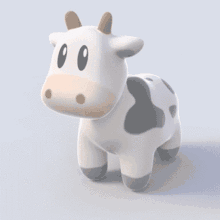Spherical cow


A spherical cow is a humorous metaphor for highly simplified scientific models of complex real life phenomena.[2][3] The implication is that theoretical physicists will often reduce a problem to the simplest form they can imagine in order to make calculations more feasible, even though such simplification may hinder the model's application to reality.
The phrase comes from a joke that spoofs the simplifying assumptions that are sometimes used in theoretical physics.[4]
Milk production at a dairy farm was low, so the farmer wrote to the local university, asking for help from academia. A multidisciplinary team of professors was assembled, headed by a theoretical physicist, and two weeks of intensive on-site investigation took place. The scholars then returned to the university, notebooks crammed with data, where the task of writing the report was left to the team leader. Shortly thereafter the physicist returned to the farm, saying to the farmer, "I have the solution, but it works only in the case of spherical cows in a vacuum".
It is told in many variants,[5] including a joke about a physicist who said he could predict the winner of any race, provided it involved spherical horses moving through a vacuum,[6][7] and a 1973 version based on a chicken.[8]
Alan Turing, in his 1952 paper "The Chemical Basis of Morphogenesis" asserted that: "a system which has spherical symmetry, and whose state is changing because of chemical reactions and diffusion ... cannot result in an organism such as a horse, which is not spherically symmetrical." [9]
Popular culture
In an episode of the sitcom The Big Bang Theory, the joke is told by Dr. Leonard Hofstadter with a slight variation, the punchline mentioning "spherical chickens in a vacuum".[10] Spherical chickens can be further traced back to a letter to the editor of the journal Science titled A Spherical Chicken from 1973.[8]
Consider a Spherical Cow is the title of a 1988 book about problem solving using simplified models,[11] and "Spherical Cow" was chosen as the codename for the Fedora 18 Linux distribution.[12]
See also
- Assume a can opener
- Fermi problem
- Frictionless plane
- Isolated system
- Occam's razor
- Naïve physics
- Unobtainium
- You have two cows
References
- ↑ Hubbard, John H.; West, Beverly H. (1995). Differential Equations: A Dynamical Systems Approach. Part II: Higher-Dimensional Systems. Texts in Applied Mathematics. 18. Springer. p. 204. ISBN 978-0-387-94377-0.
- ↑ Shelton, Robin; Cliffe, J. Allie. "Spherical Cows". Archived from the original on 9 October 1999.
- ↑ "The Sacred Spherical Cows of Physics"
- ↑ Washington Post: "The Coase Theorem"
- ↑ Kirkman, T. W. (1996). "Spherical Cow: A Simple Model". Statistics to Use. Retrieved 2007-02-19.
- ↑ Hefley, Bill; Hefley, William E.; Murphy, Wendy (1 February 2008). Service science, management and engineering: education for the 21st century. Springer. p. 80. ISBN 978-0-387-76577-8. Retrieved 28 September 2011.
- ↑ Birattari, Mauro (15 April 2009). Tuning Metaheuristics: A Machine Learning Perspective. Springer. pp. 183–184. ISBN 978-3-642-00482-7. Retrieved 1 September 2012.
- 1 2 Stellman, Steven. "A Spherical Chicken". Retrieved 18 Feb 2017.
- ↑ Turing, A. M. (1952). "The Chemical Basis of Morphogenesis" (PDF). Philosophical Transactions of the Royal Society of London B. 237 (641): 37–72. JSTOR 92463. doi:10.1098/rstb.1952.0012.
- ↑ Huva, Amy. "When Nerds go Viral". Vancouver Observer. Retrieved 6 May 2014.
- ↑ "Consider a Spherical Cow" University Science Books
- ↑ "Fedora 18 Is Codenamed The Spherical Cow". phoronix.com. 2012. Retrieved 2012-05-11.
External links
- NASA:Exploration of the Universe Division - Supernova models as spherical cows
- Hubble Heritage Gallery Page: related history from Space Telescope Institute